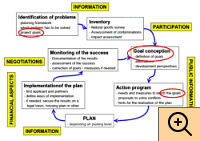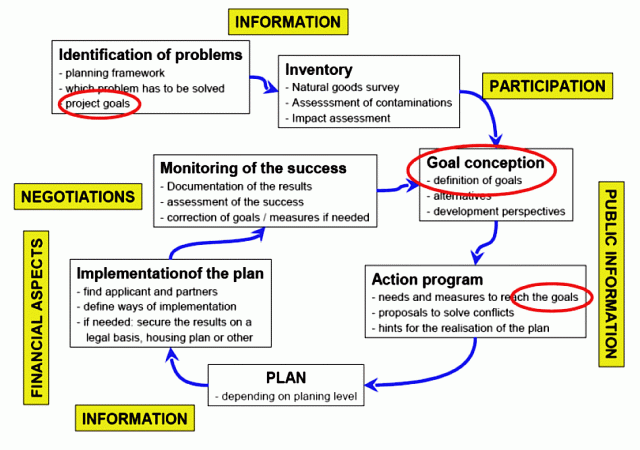 ContactImpressum
ContactImpressum
Before you start ...
Introduction to the Timeline
The project timeline includes a step-by-step guide to planning an agri-environmental project.
Each step for planning your project is described, with an explanation of a communication challenge you will face, followed by solutions to overcome these challenges.
Communication solutions may be methods, tools or useful tips, many can be applied to more than one step and communication challenge.
Navigate by clicking step 1 of the project planning timeline, and working through step-by-step. Alternatively start with the step most relevant to you.
10 Steps to planning a project
- Definition of the problem and/or the solution proposal
- Identification of possible participants of the project
- Sourcing of required data
- Identifying existing solutions
- Define the difference or gap between the reality and the desired situation
- Develop a solution (What will be done to improve the situation)
- Clarify the legal and financial background
- Finalization of the solution
- Realisation of the solution
- Check ( re-evaluate the situation and the success of the solution)
FUTURE DEVELOPMENT OF THE WEBSITE
An alternative method of accessing the information is under construction, based on what kind of problem you may have.
Checklists are under development to identify your project specific communication challenges, and link you directly to relevant solutions.
This website focuses on the communication aspects of your agri-environmental project.
Links for sourcing new technology, information or contacts who may have dealt with similar practical challenges will be provided.
For questions about technology, legal matters, financing etc. links to external services, websites and sources of information will be provided.
What is a bottom-up or top-down project?
What kind of structural organisation does your project have, or do you want your project to have?
Every organisation has a different definition for the terms bottom-up and top-down. The term bottom-up is a popular buzzword, and is often used incorrectly.
We looked at all the definitions, and the ways these structures are implemented, and came up with the optimal definitions.
Top-down project structure
There is a management hierarchy in place in all projects, companies, organisations and professions. In any position there are usually several of these at play at once.
Here are some simplified examples of the chain-of-command in top-down systems.
The Boss -> Management --> Employees
The EU --> Policy-makers --> Farmers
The Funding Committees --> The Scientific Community --> Researcher
Traditionally these are non-flexible hierarchies used for organising and managing a business, organisation or project and follow these steps:
- Decisions are made at the top
- Commands are sent down the hierarchy to those at operational level at the "bottom"
- Operational level (bottom) implements commands
Top-down organisation is efficient, standardized and the traditional way to structure a project, but there are major downsides to having a rigid top-down system. Often individuals at the "top" do not understand:
- how the operational level functions
- the processes carried out by the operational level
- the practical implications of the decisions they make
This leads to poor or ill-informed decisions which are inefficient and make the jobs of those working at the operational level harder.
Top-down systems are flawed by one-way communication, an order sent down the hierarchy with no opportunity for feedback.
Communication should always be a two-way cycle, all parties should participate.
The operational level have crucial knowledge which should be used when making decisions, in top-down systems this knowledge is wasted.
Bottom-up project structure
Those working at the operational level have unique knowledge on:
- local conditions
- local and implementation challenges
- practical applications
This knowledge is crucial to making good decisions.
In bottom-up systems this knowledge is used define project aims and to make important decisions. In this way the most regionally, locally and practically suitable solutions are reached.
The same participants are involved, but different roles of each stakeholder are required.
The people best qualified to design an agri-environmental project are those who would end up implementing it.
- You know your region, your neighbours and the local issues being faced on your farm best.
- Agri-environmental projects designed and initiated by you will be more suitable to your specific situation.
- An agri-environmental project designed by you is more likely to be successful, and both environmentally and economically beneficial.
- An agri-environmental project initiated and driven by you is more likely to be accepted by the local community.
Remember top-down structure is the standard practise, this means everyone is used their traditional top-down roles and to flawed one-way communication. Thus it can be hard to set up healthy two-way communication, and for project partners to take on a new role.
More information on top-down and bottom-up structured projects
More information on Traditional Role Problems
More information on Two-way Communication can be found bellow.
Why communication problems occur and why they are important?
All problems within agri-environmental projects are communication problems, even those that don't seem to be. Practical problems can be resolved by having:
- the correct information
- the right contacts to get advice
- open communication with an agro technology company
These are all kinds of communication.
What is communication?
Communication is a two-way exchange of information between participants, where all participants are able to interact, share and give feedback.
Different professional backgrounds
Agri-environmental projects involve collaboration between stakeholders who come from different professions such as farmers, farmers-advisors, policy-makers, governmental officials and scientists.
Stakeholders from different professions have different professional backgrounds and professional cultures. Every profession has their own:
- Mind-set and attitude
- Priorities
- Ways of approaching a problem
- Professional working language
A professional working language is adapted specifically for use within that profession, to communicate with colleagues regarding work related topics.
Differences in the way we all work and communicate, often cause small problems between different professional groups, such as:
- Misconceptions about a stakeholder group
- General misunderstandings
- Lack of respect and trust
Small problems add up and can result in the following major communication challenges:
- Language barriers between different professions
- Poor relationships between stakeholders and other professions
- Language barriers and poor relationships between scientists and other stakeholders
Professional cultural differences plus an ingrained top-down mind-set can lead to:
And now – start your process ...
 EN
EN DE
DE SE
SE FI
FI DK
DK LV
LV
